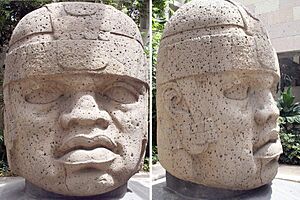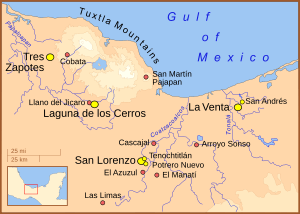San Lorenzo Tenochtitlán facts for kids

San Lorenzo Tenochtitlán is a special name for three old sites in Mexico. These sites are San Lorenzo, Tenochtitlán, and Potrero Nuevo. They are found in the southeast part of Veracruz, a state in Mexico.
San Lorenzo was one of the most important cities for the Olmec people. The Olmec were an ancient civilization. San Lorenzo was a major center of their culture from about 1200 BCE to 900 BCE. It was as important as other Olmec cities like La Venta and Tres Zapotes.
Today, San Lorenzo Tenochtitlán is famous for its huge stone heads. These are called colossal stone heads. Some of them weigh over 28 metric tons (28 long tons; 31 short tons) and are 3 metres (9.8 ft) tall!
It's important not to mix up this Tenochtitlán with the famous Tenochtitlan in Mexico City. That was the capital city of the Aztecs. The names of places were often changed during the European conquest.
Contents
What Was San Lorenzo Like?
The Olmec culture started even earlier nearby at a place called El Manatí. This was a bog where people made sacrifices. Artifacts found there date back to 1600 BCE or even before. Farmers had lived in this area for hundreds of years before San Lorenzo grew into a big center.
San Lorenzo was the first Olmec site to show a complex society. It was like a state with a government. This city became very powerful in the lowlands of the Gulf Coast. It helped spread Olmec culture throughout Mesoamerica.
San Lorenzo was the biggest city in Mesoamerica from about 1200 BCE to 900 BCE. After that, another Olmec center called La Venta started to become more important. By 800 BCE, San Lorenzo had very few people living there. However, people did return to live on the San Lorenzo plateau later, from 600 to 400 BCE, and again from about 800 to 1000 CE.
Unlike La Venta, which was in a swampy area, San Lorenzo was in a large farming region. It seems San Lorenzo was mostly a ceremonial site. It was a town without city walls. It was surrounded by many farms and people. The main ceremonial area and its buildings could hold about 5,500 people. The whole area, including the farms, might have had up to 13,000 people.
Building San Lorenzo
San Lorenzo was built on high ground, about 700 hectares (1,700 acres) in size. This area was between active rivers. The main part of San Lorenzo covers 55 hectares (140 acres). This core area was changed a lot by adding and leveling earth. Some experts think that between 500,000 to 2,000,000 cubic metres (18,000,000 to 71,000,000 cu ft) of earth were moved. This was all done by hand, basket by basket!
The rulers of San Lorenzo were very important. They helped organize the people to change the land. They made it into special places for ceremonies and daily life. This was all to show how great the San Lorenzo leaders were.
Archaeologists Michael Coe and Richard Diehl studied the area. They found that the 77 square kilometres (30 sq mi) around San Lorenzo could produce about 500 metric tons (490 long tons; 550 short tons) of corn each year. This was enough to feed over 5,500 people. This was more than the estimated population at the time. People in San Lorenzo also ate dogs, fish like snook and tarpon, and turtles.
San Lorenzo also had a clever drainage system. They used buried, U-shaped stones as pipes. These pipes directed fresh spring water to the edges of the plateau. This showed how the rulers controlled this important resource. Some researchers believe this system was not just for drinking water. It was also used for special rituals. This suggests that the rulers were closely connected to a water god.
Archaeological Discoveries

Matthew Stirling was the first person to start digging at the site in 1938. Between 1946 and 1970, four archaeological projects took place. One important study was by Michael Coe and Richard Diehl from Yale University. This happened between 1966 and 1968. After that, there was a break until 1990.
The original Olmec name for this area is not known. We also don't know the Olmec language. The name "San Lorenzo Tenochtitlán" was given by Stirling in 1955. He took it from nearby modern villages. This name refers to all the sites together. San Lorenzo itself is on a plateau that rises 50 metres (160 ft) above the Coatzacoalcos River.
The archaeological site of Tenochtitlán is inside the modern village of the same name. Potrero Nuevo is on a hill east of the plateau. Another large site is Loma del Zapote. This is a long ridge that goes south from the plateau. It includes a place called El Azuzul.
You can visit the archaeological sites of San Lorenzo Tenochtitlán. They are open Monday to Sunday, from 8:00 AM to 3:00 PM local time.
Amazing Stone Sculptures
The San Lorenzo site is famous for its many stone sculptures. Some of these sculptures show gods or supernatural beings. Others show real people. So far, 124 stone sculptures have been found. It is thought that many more are still buried.
The sculptures come in different sizes. The giant Colossal Heads can weigh up to 28 tons[convert: unknown unit]. All the stone used for these artworks came from the Cerro Cintepec volcano. This volcano is in the Tuxtla mountains.
These sculptures were not just beautiful art. They also showed how much the Olmec respected their gods. They also showed the power of the rulers. Moving such huge stones and carving them needed a lot of planning. It also required many people to work very hard.
How San Lorenzo Grew and Changed
In the 1960s, Michael Coe and Richard Diehl studied San Lorenzo. They found eight main periods when people lived there.
The earliest periods were Ojochi (around 1750–1550 BCE) and Bajío (around 1550–1450 BCE). These were before the main Olmec culture. In the Chicharras phase (around 1450–1400 BCE), more typical Olmec items started to appear.
San Lorenzo was most powerful during the San Lorenzo phase (around 1400–1000 BCE). But then, it started to decline in the Middle Formative period. This included the Nacaste (around 1000–800 BCE) and Palangana (around 800–400 BCE) phases. The number of people living there kept going down. Even though people lived in the surrounding area later, the site itself was not reoccupied until much later, from 800 to 1000 CE.
Architecture and Homes
At the top of the San Lorenzo plateau, there were huge thrones and colossal heads. There were also smaller sculptures of humans, cats, birds, and strange monsters. These showed the power of the rulers and where their power came from. Most of these sculptures were carved from imported stone.
The important people, or elites, lived in large buildings. These buildings were on low clay platforms. They were placed among the monuments that proved their power.
One elite home was called the "Red Palace." It had walls and floors made of earth. These were covered with sand stained red with a mineral called hematite. Huge columns, 4 metres (13 ft) tall, were carved from stone. They held up the roof of the building. L-shaped stone benches might have been used as steps.
Blocks of clay and limestone were found in the ruins. These might have been used in the walls. Some buildings had very thick mud walls, about 40 centimetres (16 in) thick. They were likely built using a technique called rammed earth. Other buildings used clay blocks held together with mud. Floors were made of gravel, packed earth, or clay blocks.
The common people lived on the slopes of the plateau. Their houses were made of thatched wattle-and-daub. This means they used woven branches covered with mud.
A lot of work went into building the terraces at San Lorenzo. One terrace had a 7-metre (23 ft) high wall to hold it in place. We don't know if the rulers ordered these terraces and houses to be built. Or if groups of common people started building them on their own.
Changes to the land around San Lorenzo also included raised paths or dikes. The two largest ones were along old river paths. These might have helped control floods. They also might have been docks for loading and unloading canoes.
Studies of the houses showed how they were organized. People often left trash near house walls or in pits. When people left a house, they often left trash in corners or outside. By studying this, experts could guess how the buildings were laid out. The houses seemed to follow a "solar pattern." This means separate areas for different activities, like sleeping or cooking. All these separate buildings were built around a central open area.
What San Lorenzo Traded
Different types of Olmec pottery and small figures from San Lorenzo were traded. They were sent to other areas in Mesoamerica. For example, many were found at a site called Canton Corralito in Chiapas state.
Over 5,000 objects in the early Olmec style were found at Canton Corralito. In fact, more early Olmec items were found there than at San Lorenzo itself. This shows how much San Lorenzo traded. None of the items from San Lorenzo that have been studied so far came from other areas. This suggests San Lorenzo was a producer, not just a buyer.
Why San Lorenzo Declined
We don't know exactly why San Lorenzo declined. It was replaced by La Venta around the 10th century BCE. Some ideas include internal fights or attacks from outside groups.
Many things could have caused its decline. These include wars, changes in the environment, or a decrease in trade. New rival cities also might have appeared. It's likely that several things happened at once. Evidence shows that the rivers in the area changed course around that time. This might have started or made other problems worse for San Lorenzo.
See also
 In Spanish: San Lorenzo (zona arqueológica) para niños
In Spanish: San Lorenzo (zona arqueológica) para niños
- El Azuzul, a small Olmec site very close to San Lorenzo Tenochtitlán. It might have been part of the complex.
- Tres Zapotes, another important Olmec site about 100 miles (160 km) northwest of San Lorenzo.

